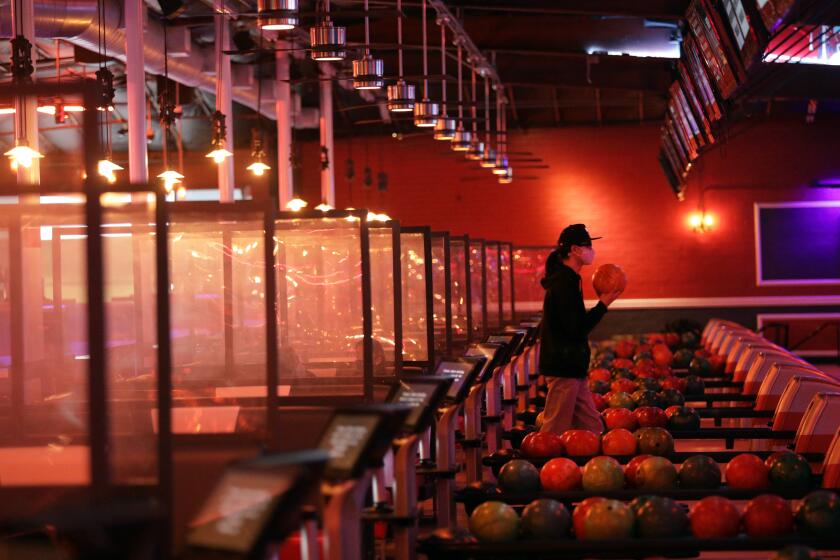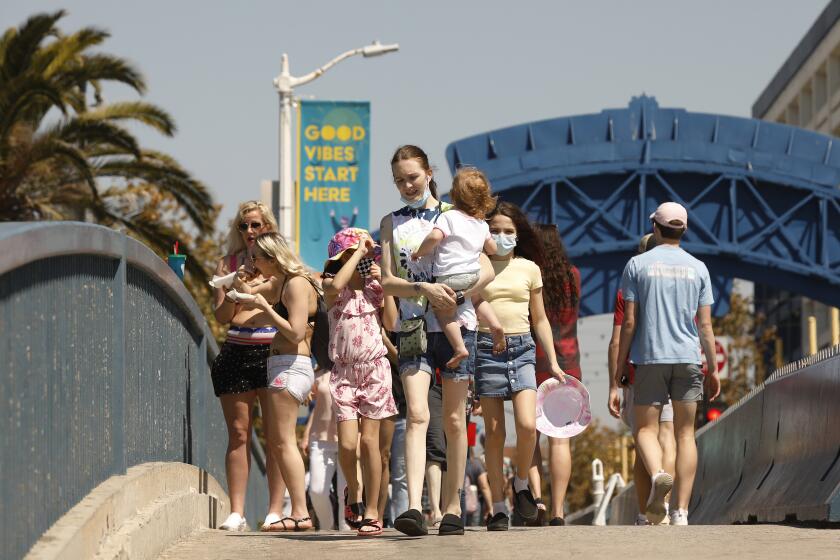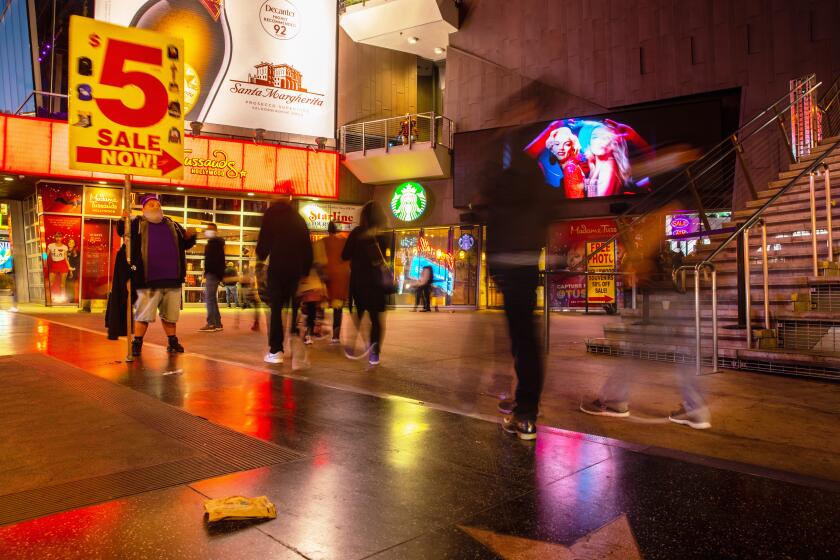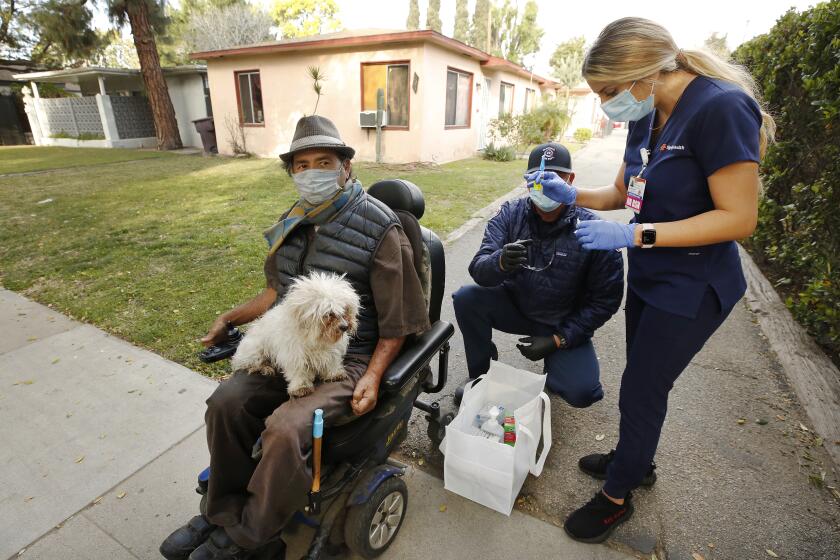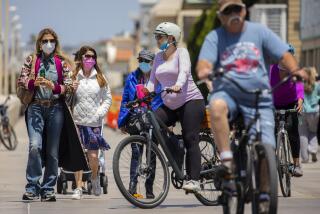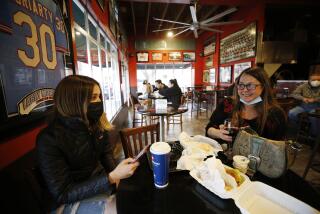L.A. and O.C. businesses cleared for more reopenings, but officials urge caution
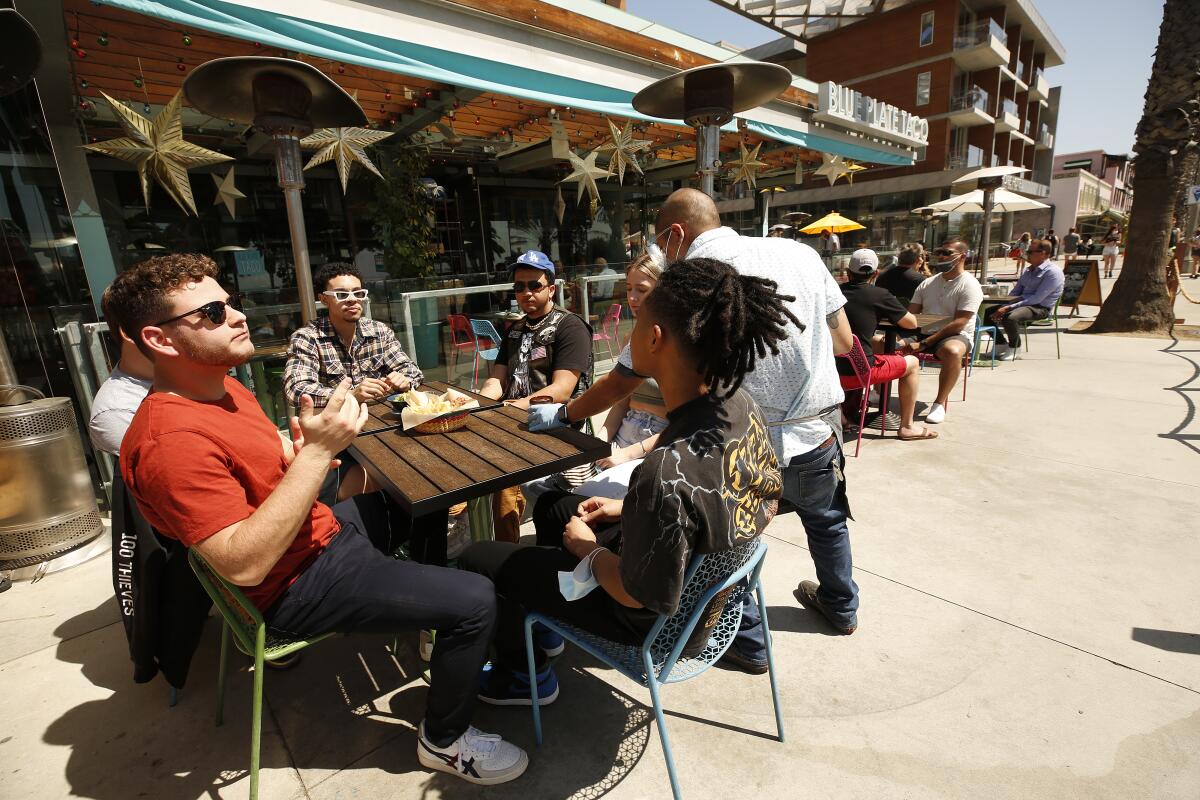
Los Angeles and Orange counties have passed a new marker on what they hope is a return to normality from the coronavirus crisis, clearing the way for them to further lift restrictions on businesses and activities.
Both counties have officially moved into California’s orange tier — the next-to-last step in the state’s reopening process, according to state data released Tuesday.
It is a significant move for the two heavily populated regions, neither of which had ever previously managed to get the number of new coronavirus infections low enough to progress this far through the color-coded, four-stage blueprint the state unveiled seven months ago.
But the two counties are diverging when it comes to the timing of their additional reopenings. Orange County will fully align with the new tier’s rules starting Wednesday — as soon as is allowed — but Los Angeles County plans to hold off for a bit.
Whatever the timeline, officials said the incremental victory was a hard-fought gain in the battle against COVID-19 — and a testament to how both individual actions and the collective vigilance of residents and businesses helped turn the tide of the pandemic after a brutal fall and winter wave.
L.A. County Public Health Director Barbara Ferrer noted Tuesday “how remarkable our numbers are, in fact, and how much we’ve made a huge step in the right direction.”
“It wasn’t a miracle. It didn’t just happen,” she said during a briefing. “There was a lot of hard work.”
County officials say moving to a less restrictive category in California’s reopening blueprint is a hard-fought gain in the battle against COVID-19.
Ferrer said a revised health officer order allowing many of the reopenings outlined in the orange tier would go into effect the morning of April 5.
Waiting a little longer, she said, will give the county more time to make sure its last round of reopenings — which began March 15 — have not increased coronavirus transmission.
“There is a good reason for us to remain in a tier for three weeks before accelerating into a less restrictive tier, because we need this third week to make sure that we’re not seeing an increase in cases,” Ferrer said. “Remember, this still is a virus that has a very long incubation period, so this week becomes critical.”
With the latest advancements, 17 of the state’s 58 counties, which are home to roughly half the state’s residents, are now in the orange tier. At the beginning of March, only two sparsely populated counties had made it that far.
Also moving to the orange tier this week were Alameda, Butte, Colusa, Modoc, Santa Cruz and Tuolumne counties.
California counties that reach the orange tier can allow bars to reopen outdoors with some modifications. Bars will no longer be required to also serve food.
Capacity restrictions can also be lifted in stores, although social distancing and other pandemic safety modifications still apply; houses of worship, museums, zoos and aquariums can raise their indoor capacity to 50% from 25%; restaurants and movie theaters can raise indoor capacity to 50% capacity or 200 people from 25% or 100 people (whichever is fewer); and indoor gyms and yoga studios can increase capacity to 25% from 10%.
Bowling alleys can reopen with modifications at 25% capacity. Card rooms and satellite wagering sites can also reopen indoors at 25% capacity.
Offices in nonessential industries can also reopen, though the state says workers should still be encouraged to work remotely.
With some other areas of the country already seeing an alarming coronavirus rebound, officials say the next few weeks are pivotal if California is to stave off yet another surge.
Starting Thursday, amusement parks can also reopen at up to 25% capacity in the orange tier.
Effective that same day, California is also allowing limited fan attendance for outdoor sports and live performances, with the cap set at 33% capacity for counties in the orange tier.
The state made the rules, but local health officials can apply stricter standards, if they feel doing so is warranted.
California’s tiered system categorizes counties based on three criteria: coronavirus case rates, adjusted based on the number of tests performed; the rate of positive test results; and a health-equity metric intended to ensure that the positive test rate in poorer communities is not significantly higher than the county’s overall figure.
The four designated tiers range from purple, in which coronavirus transmission is considered widespread, and indoor operations are suspended or severely limited across a wide array of business sectors; to red, with fewer restrictions; to orange, with even fewer; and finally, yellow, in which most businesses can open indoors with modifications.
Reaching the orange tier requires a county to have an adjusted rate of 3.9 or fewer new coronavirus cases per 100,000 people each day and a test positivity rate of under 5%, among other metrics.
More California counties are rapidly reaching a point where they can further untether themselves from the strictest rules imposed to combat the pandemic.
Counties must meet the required criteria for two consecutive weeks to advance to a less restrictive tier. Additionally, they can move forward only one tier at a time.
The state also stipulates that counties must stay in a tier at least three weeks before advancing again — as Ferrer noted Tuesday — but that timing was thrown for a loop this month when California revised its reopening blueprint after achieving a self-set goal of administering 2 million COVID-19 vaccine doses in targeted disadvantaged communities.
Upon reaching that target on March 12, the state began allowing counties with an adjusted case rate of up to 10 new cases per day per 100,000 people to exit the purple tier. Previously, counties needed to have case rates at or below seven to move from purple to red.
Counties that became eligible to progress under the new red tier threshold were allowed to do so beginning March 14.
This sparked confusion as to when exactly the three-week clock started. From the state’s perspective, however, “a county that moved during the reassignment is considered to have moved into their current tier” on March 8.
In other words, because certain counties, such as L.A. and Orange, met the relaxed red tier threshold as of March 8, they were considered to have entered the tier at that time — even though the criteria were not changed and the official move didn’t happen until later.
Biden accelerates COVID vaccinations, while a top health official says she has a sense of ‘impending doom’ amid a new wave of infections and deaths.
Fresno, Glenn, Kings, Madera and Yuba counties all moved from the purple to red tier this week, leaving just three counties — Inyo, Merced and San Joaquin — that are still mired in the state’s most stringent restrictions.
Thirty-six counties that are home to 19 million people are now counted in the red tier.
Only Alpine and Sierra counties have made it all the way to the yellow tier at this point.
The continued advancement of counties though California’s tier framework comes as federal officials are growing increasingly alarmed at the nationwide trajectory of the pandemic.
Dr. Rochelle Walensky, director of the Centers for Disease Control and Prevention, told reporters Monday that she’s been gripped by a feeling of “impending doom.”
“We have so much to look forward to, so much promise and potential of where we are and so much reason for hope,” she said. “But right now, I’m scared.”
Later that same day, President Biden implored Americans to maintain precautions, warning that, “We’re in a life-and-death race with a virus that is spreading quickly.”
Dr. Eric Toner, a senior scholar at the Johns Hopkins Center for Health Security, said “there’s no question that we’re going into a fourth surge” as “the data has indicated rising cases in most states now for a couple weeks.”
Given the current state of the pandemic, Toner said Monday that it’s especially important to keep restrictions on indoor activities.
“We shouldn’t be allowing restaurants and bars and movie theaters and places like that to resume anything that resembles normal operations,” he said. “We need to keep the density of those indoor spaces down.”
As vaccine access rapidly expands, some say vulnerable homebound individuals are being left behind.
Officials have pointed out that, unlike some other states, California has kept a number of coronavirus-related rules — such as a mask mandate — in place. Businesses also are still largely required to modify their operations, such as by reducing capacity, stepping up cleaning and disinfection protocols and reconfiguring seating/queueing areas to ensure physical distancing.
Paula Cannon, a professor of molecular microbiology and immunology at the Keck School of Medicine at USC, said she thinks the state’s tiered system represents a good compromise between public health and economic concerns.
The metrics necessary to move between tiers are clear and the system “makes sense,” she said.
“What people should recognize is the tiers are not a one-way system, so if cases start to kick up again ... we may go back into a higher tier,” she continued.
Given how worrying conditions are elsewhere in the U.S. and in other countries, some have wondered whether California should hold off on further reopenings until conditions improve or more people are vaccinated.
Cannon, though, said she thinks the tier framework is solid and should be followed.
“Not only is it based on good science, it’s also we have built in this sort of safety net that, if the numbers do start to pick up, we will move back,” she said.
With people increasingly eager to put the pandemic behind them and get back to something resembling business as usual, state officials have said they will continue to tread carefully.
“When you say, ‘Pull off your mask, let’s just go back or revert to normal,’ then that puts the virus back in control, as opposed to the work that all of you are doing to keep this virus at bay,” Gov. Gavin Newsom said during a news conference in Orange County last week. “I want to keep that progress. We’re not going to run that 90-yard dash.”
Times staff writer Chris Megerian contributed to this report.
More to Read
Start your day right
Sign up for Essential California for news, features and recommendations from the L.A. Times and beyond in your inbox six days a week.
You may occasionally receive promotional content from the Los Angeles Times.
